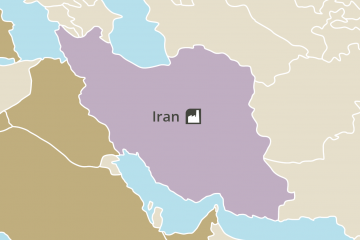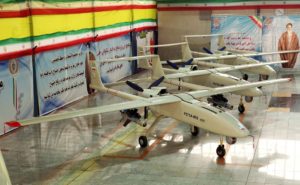
Iran
Identifying reliable information about Iran’s unmanned systems is challenging, given conflicting reports.[1] However, what is certain is that despite years of sanctions and export restrictions, Iran has managed to develop and manufacture its own UAVs, designing and building its own drone parts so as not to rely on foreign suppliers.[2]
There are two Iranian-made armed UAVs: the Shahed-129, first unveiled in 2012, and the Mohajer 6, mass produced since 2018. The design of the Shahed-129 is heavily based on the Israeli Hermes 450,[3] which suggests that Iran may have had access to one or more Israeli models, possibly lost on a covert mission, and, in line with the broader tendency of the country, it could have reverse-engineered the foreign design.[4] It is in service today, operated by the Islamic Revolutionary Guard Corps (IRGC), and it was assessed as capable of carrying out strikes in February 2016.[5] The Mohajer 6 is said to have been delivered to the IRGC’s ground forces in early 2018.[6]
Iran aims at becoming a UAV supplier and does not differentiate between state and non-state actors.[7] In particular, it seems that Iran might have supplied armed drones to Hamas, Hizbullah and the Houthis as well as the regime of Bashar Al-Assad in Syria, although evidence and details are still feeble.[8]
Hizbullah has, or at some point had, a Shahed-129 model carrying Sadid-1 missiles,[9] but it appears that, despite evidence that the group has military drones, it has used them sparingly and has recently demonstrated a preference for commercial drones.[10]
NOTES
[1] As reported in Drone Wars, for instance, although Jane’s Unmanned Yearbook, seen as an authoritative source on unmanned systems, does not list the Shahed-129 as part of Iran’s armed drones. However, this was seen conducting strikes in both Syria and Iraq, as discussed below.
[2] Iran Project, ‘Official: Iran Manufacturing Drone Parts’, 18 July 2018.
[3] Rob O’Gorman and Chris Abbott, ‘Remote Control War: Unmanned Combat Air Vehicles in China, India, Iran, Israel, Russia and Turkey’, Open Briefing, September 2013, p. 9.
[4] The technological improvements made by Iran are also believed to have been possible by
reverse-engineering the hardware of the US RQ-170 Sentinel spy drone downed in 2011, see Scott Peterson, ‘Downed US Drone: How Iran Caught the “Beast”’, Christian Science Monitor,
9 December 2011.
[5] UPI, ‘Iran Claims Breakthrough with Israeli-Lookalike Combat UAVs’, 7 October 2013.
[6] Jeremy Binnie, ‘Iran’s Mohajer 6 Armed UAV Goes into Production’, Jane’s 360, 7 February 2018.
[7] Ariane Tabatabai, ‘Decades in the Making: The Iranian Drone Program’, Bulletin of the Atomic Scientists, 12 October 2017.
[8] Reports about the delivery of the Shahed-129 to Iran-backed groups under the Popular Mobilisation Front in Iraq have so far not been confirmed.
[9] Michael C Horowitz, Sarah E Kreps and Matthew Fuhrmann, ‘Separating Fact from Fiction in the Debate Over Drone Proliferation’, International Security (Vol. 41, No. 2, 2016), p. 36.
[10] Peter Bergen et al., ‘Non-State Actors with Drone Capabilities’, New America, <https://www.newamerica.org/in-depth/world-of-drones/5-non-state-actors-drone-capabilities>, accessed 30 May 2018.
Armed UAV inventory

Drone
Mohajer-6
Type
Medium Altitude, Long Endurance (MALE) type UAV
Manufacturer
Ghods UAV Industries
Number
5-10
Endurance
Est. 16-24 hours depending on payload carried
Loaded Weight
Est. 1000kg
Payload Capacity
Est. 200kg
Range
150km (limited by line of sight to Ground Control Station (GCS))
Sensor Options
Infra-Red, Electro-Optical, and Laser designator
Weaponry
At least two Sadid 345 anti-tank guided missiles (unlicensed copies of Rafael Spike)

Drone
Shahed-129
Type
Medium Altitude, Long Endurance (MALE) UAV
Manufacturer
Shahed Aviation Industries
Number
25-40
Endurance
15-24 hours depending on model, payload fit
Loaded Weight
Est. 400kg
Payload Capacity
Est. 150kg
Range
150km (limited by line of sight to Ground Control Station (GCS))
Sensor Options
Infra-Red, Electro-Optical, and Laser designator
Weaponry
Option for 4 x Sadid 345 anti-tank guided missiles (unlicenced copies of Rafael Spike)
Armed UAVs are viewed in Iran as a way to compensate for the vulnerabilities of its conventional air force, which dates to the 1970s and struggles to keep up with the times given the sanctions still imposed on the country, as well as to enhance the prestige of Iran as a state capable of fielding modern military capabilities in the eyes of domestic and international audiences.[1] The use of low-cost, low-risk tools such as drones is also in line with Iran’s defence doctrine, which prioritises asymmetrical warfare to project long-distance reconnaissance or offense capabilities to deal with enemies without risking Iranian lives.[2] This is especially the case in a scenario in which Iran perceives that it has to operate in an environment of high threat, for which its conventional military capabilities are not sufficient. The acquisition and introduction into service of armed UAVs thus led Iran to change its airpower norms and behaviours.
Much of Iran’s drone development has been driven by the IRGC’s Aerospace division, with the IRGC, the army and the defence ministry being the main beneficiaries of this technology.[3]
The IRGC is very proud of the country’s UAV capabilities. For instance, the Shahed-129 was described by them as a major technological breakthrough, while drones in general are deemed to be a ‘smart, accurate and inexpensive technology’ that makes it ‘easy to handle the work of thousands of soldiers, checkpoints, and various borderline structures that face a lot of hardship and vulnerabilities’.[4]
Iran deploys UAVs mainly to deal with counterterrorism threats, especially in its border areas, as well as in neighbouring countries which Tehran deems are unable or unwilling to tackle terrorism.[5] The Shahed-129, in particular, has been used to hit targets in Syria and Iraq.[6] In Syria, where Iran has not deployed any manned combat aircraft, strikes have been conducted against Daesh and rebel forces but also, at least on one occasion, against coalition forces.[7] In Iraq, where combat aircraft (Su-25 and F-4) were deployed in 2014 to fight the war against Daesh, Shahed-129 UAVs have been used since 2016 to deal with this threat without risking pilots’ lives.
Iran has also repeatedly violated Israeli airspace with armed UAVs from bases in Syria, in several cases provoking armed Israeli responses against those airbases (such as the T4 airbase).[8] Even though these appear to be single-use reduced-radar signature-guided munition-type UAVs based on reverse-engineering of the airframe of a captured American RQ-170 Sentinel spy drone, rather than the types used for strikes in Iraq and Syria, the incident led to a worrying escalation of tensions between Iran and Israel.[9]
NOTES
[1] O’Gorman and Abbott, ‘Remote Control War’, p. 9; Iran Project, ‘Iran Among Top Seven Powers in Military Drone Industry: Top General’, 10 October 2018.
[2] Ariane Tabatabai, ‘Containment and Strike: Iran’s Drone Program’, Terrorism Monitor (Vol. 15,
No. 17, 11 September 2017).
[3] Ibid.; O’Gorman and Abbott, ‘Remote Control War’, p. 9.
[4] Iran Project, ‘Commander: Iran’s Ground Force Expanding Drone Fleet’, 12 April 2017; Young Journalists Club, ‘The Construction of UAV Shahed-129 has Security Implications for Iran’s Islamic Republic/Construction of Iran’s RQ170’, author’s translation, 27 September 2013, <https://www.yjc.ir/fa/news/4570397>, accessed 20 September 2018.
[5] Tabatabai, ‘Containment and Strike’.
[6] Albin Szakola, ‘Iran Admits Conducting Drone Strikes in Syria’, Business Insider, 26 September 2016; Dan Gettinger, ‘Drones Operating in Syria and Iraq’, Center for the Study of the Drone, December 2016, <http://dronecenter.bard.edu/files/2016/12/Drones-in-Iraq-and-Syria-CSD.pdf>, accessed 29 September 2018.
[7] Julian Borger, ‘US Shoots Down Second Iran-Made Armed Drone over Syria in 12 Days’, The Guardian, 20 June 2017.
[8] Natasha Turak, ‘Israel “Will be Punished” for its Strike on Iranian Drone Base, Tehran Says’, CNBC, 18 April 201.
[9] Ibid.